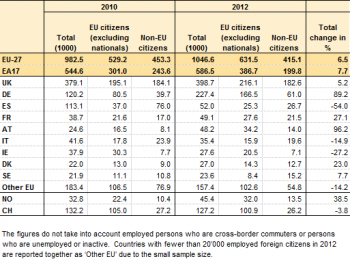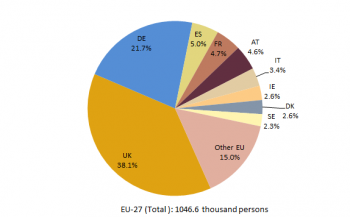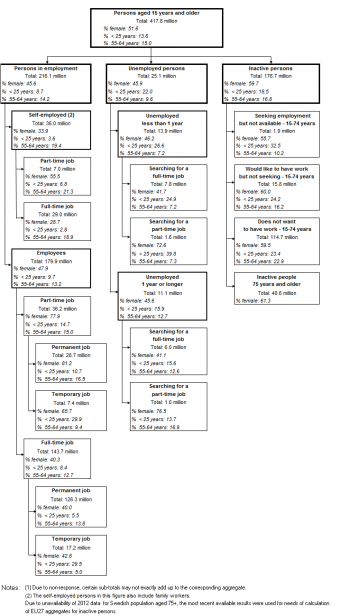Archive:Labour force survey overview 2012
European Union Labour force survey - annual results 2012
Statistics in Focus 14/2013; Author: Martin TEICHGRABER
ISSN:2314-9647 Catalogue number:KS-SF-13-014-EN-N
This publication presents the main results of the EU Labour Force Survey for the EU-27 as a whole and for all Member States for the year 2012. It covers important indicators such as the employment rate, part-time employment as a share of total employment, number of employed persons by economic activity and occupation, average weekly working hours, the percentage of employees with a limited duration contract, size and structure of self-employment, unemployment rate, long-term unemployment and the youth unemployment ratio..

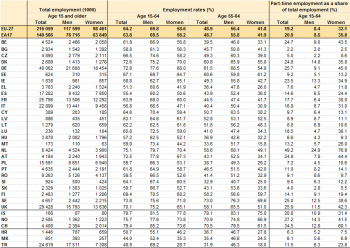

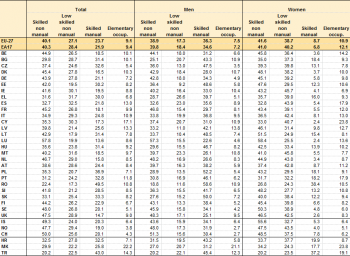
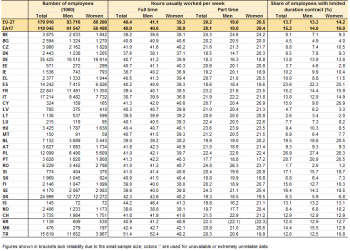
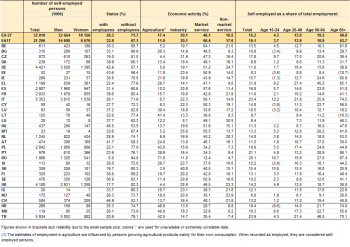
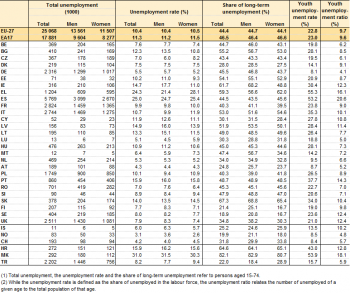
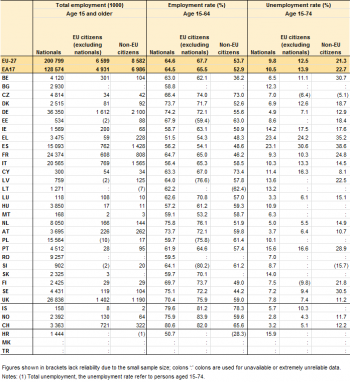
Main statistical findings
In 2012, the EU labour market was still being determined by the economic crisis. Key figures for the EU did not improve: they either continued to show negative trends (unemployment) or remained relatively stable in relation to the year before (employment). In addition, developments in the labour market did not affect Member States in the same way or to the same extent. As a result, the differences between Member States increased. The 2012 EU employment rate [1]for persons of working age (15-64) dropped slightly to 64.2 % (- 0.1 pps compared with 2011). For men, it fell to 69.8 % (-0.3 pps), while for women it rose marginally to 58.6 % (+0.1 pps) (see Table 1).
The employment rate for the population aged 15-64 was higher than the EU average (64.2 %) in eleven EU Member States. The highest rates were recorded by the Netherlands (75.1 %), Sweden (73.8 %), Germany (72.8 %), Denmark (72.6 %), and Austria (72.5 %). By contrast, ten Member States did not reach 60 %. The lowest employment rates were observed in Greece (51.3 %), Spain (55.4 %), Italy (56.8 %) and Hungary (57.2 %). The employment rates for the EFTA countries were above 75 %, with Iceland and Switzerland recording 79.7 % and 79.4 % respectively in 2012. Compared with 2011, the employment rate increased by 2 pps or more in two countries: Latvia (2.3 pps) and Estonia (+2.0 pps). On the other hand, the employment rate fell by more than 2 pps in Spain (-2.3 pps), Portugal (-2.4 pps), Cyprus (-3.0 pps) and Greece (-4.3pps).
The employment rate for the narrower age group of 20-64 year-olds is used as one of the headline indicators in the context of the Europe 2020 strategy [2]. The EU employment rate for persons in this age class fell in 2012 by 0.1 pps to 68.5%, well below the target rate of 75 % (Europe 2020 strategy) by 2020.
In 2012, 216.1 million persons were employed in the EU
The labour force in the EU (i.e. the total of employed and unemployed persons) reached 241.1 million persons in 2012, an increase of 1.1 million or 0.4 % on 2011. The number of persons in employment fell by around 1.0 million to 216.1 million persons in 2012; in absolute terms the decrease in the number of employed men (-0.8 million persons) was about four times higher than for employed women (-0.2 million persons) (see Table 1).
In contrast to the general trend, employment of older persons increased. The employment rate for those aged 55-64 rose in the EU to 48.9 % (+1.5 pps compared with 2011). It increased to 41.8 % for women (+1.6 pps) and to 56.4 % for men (+1.2 pps). Sweden recorded a very high employment rate of 73.0 % in this age group. The countries with the lowest employment rates for persons aged 55-64 were Slovenia (32.9 %), Malta (33.6 %), Greece (36.4 %) and Hungary (36.9 %).
Part-time employment continued its upward trend in 2012. Its share of total EU employment reached 19.2 %, up 0.4 pps on 2011.
Among the EU countries, part-time employment was highest in the Netherlands (49.2 % of employed persons) and lowest in Bulgaria (2.2 %) and Slovakia (4.0 %). The proportion of women in part-time employment in the EU (32.1 %) is about four times higher than that of men (8.4 %).
70.1 % of the employed persons in the EU worked in the service sector
In 2012, more than two-thirds of all employed persons in the EU worked in services: 39.6 % were involved in market-oriented services such as trade, transportation, accommodation and food services, information and financial activities and real estate. 30.5 % were employed in public administration, education, human health, arts, entertainment and recreation and other services.
24.9 % of employed persons worked in industry and construction, while agriculture accounted for 5.0 % (see Table 2).
Sizeable differences still persist between Member States. Agriculture continues to be a significant source of employment in Romania (29.0 % of the working population in 2012), whereas it accounts for only a very small share (below 2 %) in Germany, Belgium, the United Kingdom, Luxembourg and Malta. The relevance of industry (manufacturing and construction) was highest in the Czech Republic (38.1 %) and Slovakia (37.5 %), and lowest in Luxembourg (12.7 %). The share of market services was highest in Cyprus (48.0 %), and non-market services were most prominent in Luxembourg (42.6 %).
Of the women employed in the EU, 44.6 % worked in non-market services and 12.5 % in industry (including construction). For men, the picture is almost the reverse, as 35.2 % worked in industry and 18.6 % in non-market services.
40.1 % of employed persons in the EU were skilled non-manual workers
Skilled non-manual workers (i.e. legislators, senior officials, managers, professionals, technicians and associate professionals) made up the largest occupational group in the EU in 2012, accounting for 40.1 % of all employed persons. Luxembourg had the highest share (57.8 %).
Skilled manual workers (e.g. plant and machine operators, craft workers) accounted for 23.7 % of total EU employment. In 2012, Romania (49.5 %) recorded the highest proportion of skilled manual workers followed by Poland (36.9 %). The proportion of men and women working as skilled manual workers in the EU is quite different: 36.3 % of all employed men and 8.7 % of all employed women.
9.1 % of employed persons in the EU had an elementary occupation, with Cyprus recording the highest share (17.1 %) (see Table 3).
Weekly working hours for full-time employees ranged from 38 hours to 42 hours in the EU
Employees accounted for 83.3 % of total EU employment in 2012. They accounted for more than 90 % of all employed persons in Estonia (91.4 %), Luxembourg (91.0 %) and Denmark (90.9 %). The figure was below 70 % in both Greece (63.2 %) and Romania (67.3 %).
Full-time employees usually worked 40.4 hours per week in 2012. In the United Kingdom and Austria, full-time employees worked the longest weekly hours (42.3 and 41.8 respectively), whereas the usual weekly hours worked by full-time employees were below 39.0 in Denmark (37.6), Ireland and Italy (both 38.7). The usual weekly hours worked by part-time employees amounted to 20.2 on average in the EU in 2012. They were highest in Romania (24.8), Sweden and Belgium (24.3), and lowest in Portugal (17.7), Germany (18.3), Denmark (18.5) and Spain (18.6) (see Table 4).
Employees with temporary work contracts accounted for 13.7 % of all employees in the EU. The highest share was in Poland (26.9 %) and Spain (23.6 %), but it was below 5 % in Romania (1.7 %), Lithuania (2.6 %), Estonia (3.7 %), Bulgaria (4.5 %) and Latvia (4.7 %).
In the EU 15.2 % of all employed persons were self-employed
Self-employed persons accounted for 15.2 % of total EU employment in 2012 (see Table 5). The highest proportion of self-employed persons was recorded in Greece (31.9 %), Italy (23.4 %), Portugal (21.1 %) and Romania (20.1 %). The lowest proportion was registered in Estonia (8.3 %), Luxembourg (8.4 %), Denmark (8.9 %) and Lithuania (9.7 %). 28.3 % of self-employed persons in the EU have employed staff. The rates for those with staff were highest in Hungary (46.5 %), Estonia (43.6 %), Germany (42.9 %) and Austria (41.7 %).
Self-employed persons worked mainly in market services (46.1 %) with the highest proportion in Spain (57.6 %), Italy (56.1 %) and Malta (55.5 %). In agriculture there are major discrepancies between countries. Agriculture is a relatively important economic activity for self-employed persons in Romania (71.9 %), Poland (43.0 %), Lithuania (41.4 %) and Portugal (39.9 %), whereas it accounted for less than a 5 % share in Slovakia (3.5 %), the Czech Republic and the United Kingdom (both 4.4 %).
The unemployment rate in the EU was 10.4 %. Almost half of all unemployed were long-term unemployed
Unemployment rose in the EU by 2.0 million persons in 2012 to 25.1 million (see Table 6). The increase affected both women and men. The number of unemployed women rose by 0.9 million to 11.5 million, and for men it increased by 1.1 million to 13.6 million. The EU unemployment rate in 2012 was 10.4 %, an increase of 0.8 pps on 2011. In 2012, the rate ranged from 4.3 % in Austria, 5.1 % in Luxembourg, 5.3 % in the Netherlands and 5.5 % in Germany to 25.0 % in Spain, followed by Greece (24.3 %) and Portugal (15.9 %).
44.4 % of unemployed persons in the EU in 2012 had been out of work for 12 months or longer. These long-term unemployed accounted for over half of total unemployment in Slovakia (67.3 %), Ireland (61.7 %), Greece (59.3 %), Bulgaria (55.2 %), Estonia (54.1 %), Italy (53.0 %) and Latvia (51.9 %), while the share was below 25 % in Sweden (18.9 %), Finland (21.4 %) and Austria (24.8 %).
In 2012, the unemployment ratio of the young population aged 15-24 in the EU was 9.7 %. While the unemployment rate is defined as the share of unemployed in the labour force for an age group, the unemployment ratio relates the number of unemployed of a given age to the total population of that age. The highest youth unemployment ratios were recorded in Spain (20.6 %), Greece (16.1 %), and Portugal (14.3 %). The lowest ratios (6 % or lower) were recorded in Germany, Luxembourg, Austria and the Czech Republic.
15.2 million foreign citizens worked in the EU, accounting for 7.0 % of total EU employment
Among the 15.2 million employed foreign citizens, 6.6 million were citizens from another EU Member State and 8.6 million were non-EU citizens. The highest proportion of foreign citizens of all the employed persons in the EU was recorded in Luxembourg (49.9 %) and Cyprus (22.7 %). Among the EFTA countries, Switzerland had a relatively high share of employed foreign citizens (23.7 %).
The employment rate for foreign citizens with an EU citizenship is significantly higher (67.7 %) than that for non-EU citizens (53.7 %). In sixteen Member States the employment rate for foreign citizens from within the EU is even higher than the rate for nationals. Rates were highest in Slovenia, Latvia, the Netherlands, the United Kingdom and Poland. Among foreign citizens with a citizenship from a non-EU country, only the Czech Republic and Cyprus recorded an employment rate above 70 % (see Table 7).
In the EU the unemployment rate is generally higher for foreign citizens than for nationals. In 2012, the EU unemployment rate for foreign citizens with a citizenship from another EU country was 12.5 %, whereas for foreign citizens with a citizenship from outside the EU the rate was almost twice as high (21.3 %). The highest unemployment rates for non-EU foreign citizens were observed in Spain (38.6 %), Greece (35.2 %) and Sweden (30.5 %). Rates of around 10 % or lower were recorded in the Czech Republic, Cyprus and Austria.
One million of employed persons recently moved within or into the EU
Around one million employed persons took up residence in an EU Member State other than their country of citizenship or from outside the EU within the last two years. Within this group around 630’000 persons were EU nationals from another Member State and some 415’000 were non-EU nationals. Of these, 38.1 % took up residence in the United Kingdom, 21.7 % in Germany, 5 % in Spain, 4.7 % in France, 4.6 % in Austria and 3.4 % in Italy (see Figure 2). Compared with 2010, the total number of non-national employed persons who recently moved to an EU country other than their country of citizenship increased by 6.5 %. However the trends were very different across Member States (see Table 8).
EU Member States with a comparatively low unemployment rate recorded an increase in recently employed non-national persons in their country, while those with a comparatively high unemployment rate recorded a decrease. The inflow nearly doubled in Austria (96.2 %) and in Germany (89.2 %). By contrast, it declined in Spain (-54.0 %) and Italy (-14.9 %) compared with 2010.
Most of these persons did not move alone within or into the EU. In 2012, around 1.7 million family members [3] took up residence with them.
Synoptic overview of different categories in the labour market
The synoptic overview (see Figure 3) summarises key results on the labour status of persons aged 15 years and older in the EU-27. The information comprises the following categories: employed, unemployed and inactive persons.
The results include information on self-employed persons, employees, persons in part-time and full-time jobs and persons in permanent and temporary jobs. Furthermore, the results also contain information on short- and long-term unemployment and the number of persons seeking for a full-time or part-time job.
The results cover absolute numbers and the specific proportion of females, as well as of young and elderly persons.
Data sources and availability
Source: the European Union Labour Force Survey (EU-LFS) is a large sample, quarterly survey providing results for the population in private households in the EU, EFTA, and the Candidate Countries. Conscripts in military or community service are not included in the results.
Reference period: Yearly results are obtained as annual averages of quarterly results.
Coverage: The data for France cover the metropolitan territory (excluding overseas regions).
European aggregates: EU refers to the sum of EU-27 Member States and EA to the sum of the 17 Euro Area Member States. When data are unavailable for a country, the calculation of the corresponding aggregates takes into account the data for the same country for the most recent period available.
Definitions: The concepts and definitions used in the survey follow the guidelines of the International Labour Organisation.
Employment (LFS concept) covers persons aged 15 years and over (16 and over in Spain, Italy and the United Kingdom, 15-74 years in Estonia, Latvia, Hungary, Finland, Sweden, Norway, Denmark, and 16-74 years in Iceland), living in private households, who during the reference week performed work, even for just one hour, for pay, profit or family gain, or were not at work but had a job or business from which they were temporarily absent, for example because of illness, holidays, industrial dispute or education and training. Employment rates are calculated for different age groups as a percentage of the population in the same age group.
The LFS employment concept differs from national accounts domestic employment, as the latter sets no limit on age or type of household, and also includes the non-resident population contributing to GDP and conscripts in military or community service.
Unemployment covers persons aged 15-74 (16-74 in Italy, Spain, the United Kingdom and Iceland) who were without work during the reference week, were currently available for work and had either been actively seeking work in the past four weeks or had already found a job to start within the next three months.
Long-term unemployment covers persons unemployed for one year or more. Youth unemployment is unemployment among persons aged 15 to 24.
Nationality: Nationality is interpreted as citizenship. Citizenship is defined according to the national legislation of each country.
Definitions of indicators reported in this publication are available on the EU-LFS Statistics Explained website:
EU Labour Force Survey (Statistics Explained)
Classifications: Economic activity: the breakdown by economic activity is based on the classification NACE Rev 2 with the following correspondence: NACE section A – agriculture, sections B to F – industry (including construction), sections G to N – market services, and sections O to U – non-market services.
Occupation: The International Labour Organisation has revised the International Standard Classification of Occupations. The LFS uses the revised classification (ISCO 08) from 2011 onwards. The breakdown of employed persons by occupation is based on the classification ISCO 08 (groups 1 to 3 for ‘skilled non manual’, 4 to 5 for ‘low skilled non manual’, 6 to 8 for ‘skilled manual’ and 9 for ‘elementary occupations’; armed forces are excluded from the calculations).
Context
Further Eurostat information
Publications
Main tables
Database
Dedicated section
Methodology / Metadata
Source data for tables, figures and maps (MS Excel)
See also
Notes
- ↑ Employment rates represent employed persons (LFS concept, see methodological notes) as a percentage of the population in the same age group.
- ↑ The European Strategy for a smart, sustainable and inclusive growth (Europe 2020) aims to raise to 75 % the employment rate for men and women aged 20-64 for the EU as a whole. This headline target is translated into specific targets for each Member State (see Conclusions of the European Council — 17 June 2010). For detailed data at EU and at national level for the 20-64 age group, see the dedicated section on Europe 2020 indicators.
- ↑ Family members include spouses and children in the same household with less than two years residence in an EU Member State other than their country of citizenship or with a non-EU citizenship.
